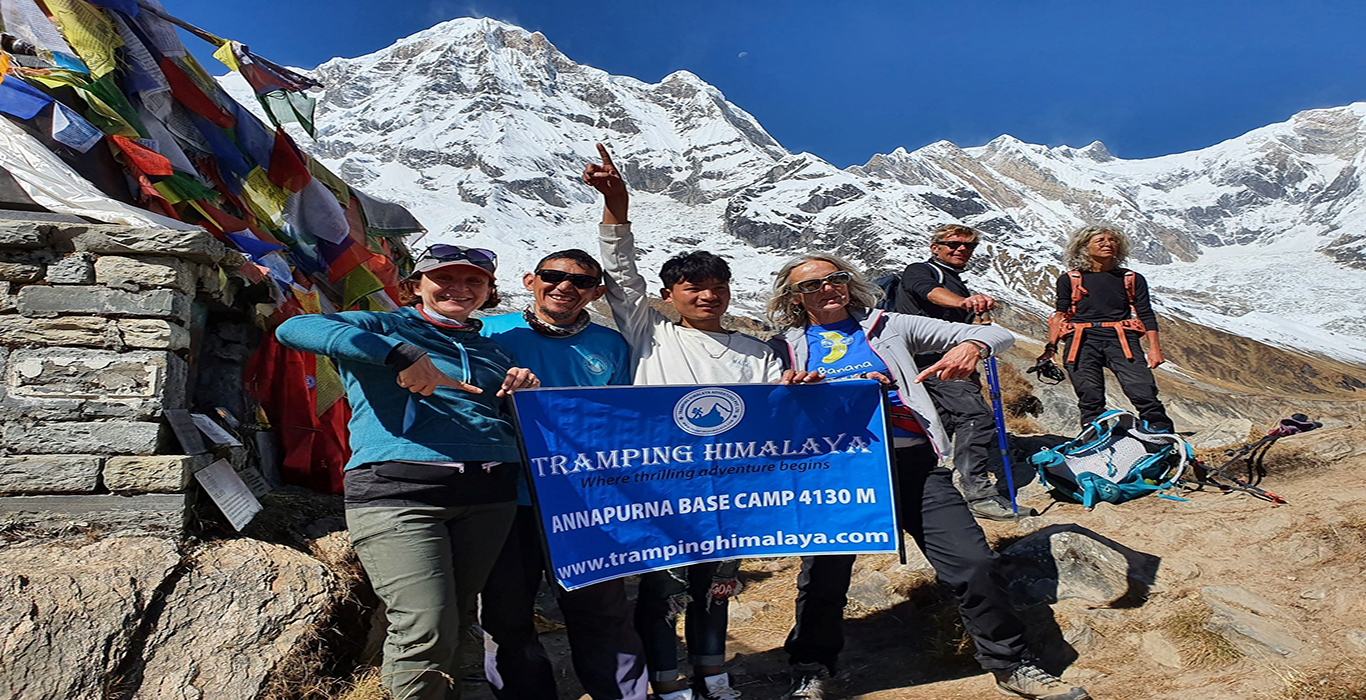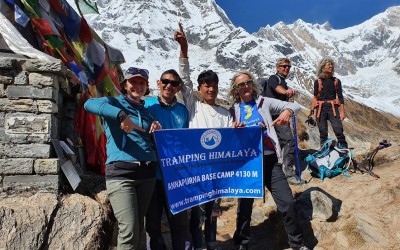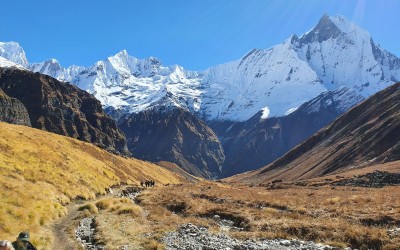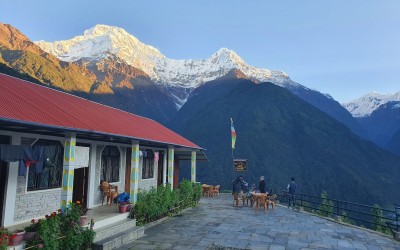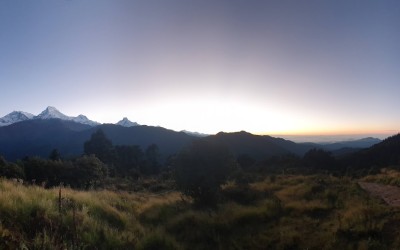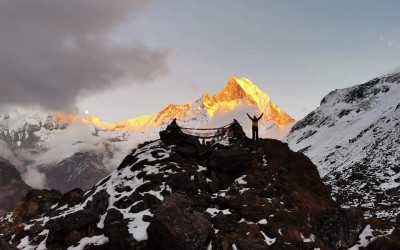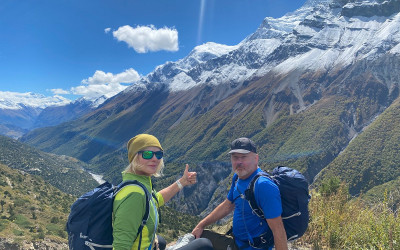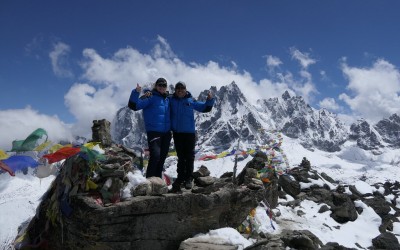Equipment List
Correct Clothing & Equipments are essential for a safe and enjoyable trek. Experienced trekkers will often take only a selection of these items based on what has worked in the past. Please find the equipment list below for your personal use during your travel with us.
FOOTWEAR ( RUNNING SHOES) :
1 pair for casual Comfortable support shoes wear on lighter walking days.
LIGHT HIKING BOOTS :
1 pair of sturdy hiking boots in which you should wear a light synthetic sock under a warm heavy sock comfortably, either wool or synthetic. Sole should be flexible but still provide enough support for your feet. Boots should be very water repellent.
HIKING GAITERS (Optional) :
1 pair keeps rocks out of shoes and boots dry in case of precipitation. Optional if trekking pants are worn.
WOOL SOCKS :
3 pair heavyweight wool socks to be worn over the liner socks. When layering socks, check fit over feet and inside boots. Remember to keep one fresh, dry pair of socks available at all times. Socks with padded shins are especially nice with boots.
LINER SOCKS :
3 pair of smooth thin wool, nylon or Capilene to be worn next to the skin. This reduces the incidence of blisters and hot-spots and makes the outer sock last longer before needing to be changed. They should fit well with your heavyweight socks.
CLOTHING ( LIGHTWEIGHT LONG UNDERWEAR ) :
2 pair, tops & bottoms, Capilene, other synthetic or wool. No Cotton. Lightweight is preferable as it is more versatile (worn single in warmer conditions and double layer for colder). Zip-T-neck tops allow more ventilation options. One set of white for intense sunny days and one pair of dark for faster drying gives the most versatility.
LIGHT TREKKING PANTS :
Lightweight nylon pants designed to be used while trekking. They are extremely air permeable, dry quickly and provide sun protection. Zip-off lower leg sections are convenient for switching to shorts.
T-SHIRTS :
Lightweight crew style t-shirt that wicks away moisture. Shirt can be made of any synthetic material.
BANDANA :
Bring bandanas for face masks and other tasks.
SYNTHETIC/SOFT SHELL JACKET :
A full-zip version is easier to put on and has better ventilation than a pullover.
INSULTED DOWN-JACKET :
Medium to heavy weight with hood.
HARD SHELL JACKET WITH HOOD :
We recommend a waterproof breathable shell material with full front zipper, underarm zips, and no insulation. This outer layer protects against wind and rain.
HARD SHALL PANTS :
Waterproof, breathable. Any side zipper length is fine as long as you can get them over your boots.
HANDWEAR » FLEECE/SOFT SHELL GLOVES :
1 pair. A heavier fleece will do a better job of keeping hands warmer when wet than lighter polypropylene or Capilene.
SHELL GLOVES WITH INSULATION :
1 pair. Insulation does not need to be removable. A good quality ski glove is sufficient
HEADWEAR » HEADLAMP & SPARE BATTRIES
A good quality climbers headlamp. For use at night, bring extra batteries!
SUN HAT :
The sun can be intense at high altitude. A hat with a good visor provides protection for the nose and eyes. Baseball hats work well. A Buff is recommended to reduce the amount of dust inhaled while trekking and reduces the chance of infection.
NECK GAITER OR BUFF :
Buff is preferred for covering the face and preventing sickness.
GLACIER GLASSES :
100% UV, IR, high quality optical lenses designed for mountain use, must have side covers, leashes, and a nose guard is particularly helpful. No more than 8% light transmission. If you wear contact lenses we recommend packing a spare pair of glassesit is a good idea to have these with photo-gray or equivalent light-sensitive material so they can double as emergency sunglasses. If you wear glasses we recommend prescription glacier glasses (gray or amber). Talk to your eye care professional to find out where prescription glacier glasses are available. Regular sunglasses are not dark enough and do not provide any side protection from the sun.
PERSONAL EQUIPMENT » SLEEPING BAG :
High quality with hood to at least - 10 Degree, Down is lighter and less bulky, but more expensive than synthetics. (Company provide you sleeping bag for this trek)
BACKPACK :
A day pack big enough to carry water bottles, camera, lunch and extra clothing. 3,000cu.in. max
ADJUSTABLE 3 SECTION TREKKING POLES : Optional » WATER TREATMENT TABLETS :
Iodine or Chloride Dioxide tablets. A small bottle or multi pack is sufficient. Taste neutralizer tablets remove iodine taste. Chloride Dioxide formulas will not discolor water
WATER BOTTLES :
2 Wide mouth bottles with minimum 1 Litre capacity per bottle. No water bag or bladder systems, they freeze or are hard to fill.
PEE BOTTLE (Optional) :
but very useful.
PEE FUNNEL FOR WOMEN (Optional) :
Lightweight urinary director. (For minimal undressing for discreet use)
SUNSCREEN :
SPF 30 or better, 2 small tubes. Make sure that the sun screen is not older than 6 months. Sunscreen older than six months loses half of its SPF rating.
HAND/FOOT WARMERS (Optional) :
Recommended if you easily get cold hands and feet 1-3 pairs.
LIP SCREEN :
SPF 30 or better, at least 2 sticks. Not older than 6 months.
MP3 PLAYER (Optional) :
Flash memory only players since hard drive players do not work at high altitude (above 13,000ft). Chargers can be used at several lodges along the way.
TRAVELING » LARGE DUFFLE BAG WITH TRAVEL LOCKS :
1 for transporting and storing gear. These bags are needed to transport your clothing.
PLASTIC BAGS (5) :
For lining stuff sacks & pack to keep gear dry. Trash compactor bags work best.
TRAVEL CLOTHES :
You will need street/casual clothing for air travel days and time spent in Kathmandu.
TOILETRY BAG :
Include toilet paper, soap, towel, and toothbrush, Wet wipes 1-2 per day and hand sanitizer: Hand moisturizer.
FIRST AID » PERSONAL FIRST AID KIT (small and simple) :
Aspirin, Moleskin, Adhesive tape, Band-Aids.
DRUGS/MEDICATIONS/PRESCRIPTIONS :
Climbers should bring Mupirocin (Bactroban) cream, excellent topical antibiotic for scrapes and cuts. Cirprofloxin (Cipro) 500mg tablets for travelers diarrhea and for urinary tract infections. Loperamide (Lomotil) or Immodium for diarrhea. Acetazolamide (Diamox) 125 or 250mg tablets for alltitude sickness. Ibuprofen (Advil, Motrin) 200mg tablets for altitude headaches, sprains, aches, etc. Excedrin for headaches. Acetaminophen (Tylenol) 325mg tablets for stomach sensitivity.
Trekking Group
Nepal has abundance of offers to establish it as a round the year travel destination. Based on this fact, many international tourists are indeed incorporating Nepal in their wishful travel itinerary. For this Everest Base Camp trek, in our trekking group there will be one trek leader and one Sherpa porter for each group of two trekkers but we provide one assistant guide as per group size. Generally in our group the minimum number of tourist will be two and the maximum group size is ten. For single traveler, we organize the trip with single supplement. We saying 10 people are our maximum pax for the trek doesn't mean we are not operating more than 11 persons, we do it on request. However it is good to keep the limit group size which means we can provide a best services and personal take care to our valuable clients during their trip with us.
Physical and Mental Requirements
Trekkers who are making their plan to travel in the Himalaya, most require three basic components of preparation - aerobic, strength, and mental. Aerobic conditioning is important primarily because you will trekking in thin air, up to 50% less than at sea level. With good aerobic conditioning you will be able to minimizing the potential effects of Altitude Mountain Sickness (AMS). Hiking for at least two hours per day with some weight on your back is the best way to prepare yourself for trekking. Running, cycling (outdoor or stationary), Nordic track, hill climbing, or any exercise that gets your heart rate into the aerobic range for sustained periods of time. Every day you will walk in the Himalaya around 4 to 7 hrs and reaches at highest place to 5550m/18204 feet. So, health is a most essential part for your adventure travel. Tramping Himalaya Adventures most require your medical fitness certificate prior to your booking. Before the trip booking with us we suggest to consult with your Medical Doctor and in his/her references go for your trip booking process. Trekking in the Himalayas is a relatively safe activity and mishaps or problems are usually minor. However, unpleasant things can occur on a long trek. You might have a bout of mild illness, not sleep as well as usual, find the trek pace too fast or slow - any number of things might be annoying or stressful during some part of your trek. Before you leave for Nepal, or for any foreign destination for that matter, think about the journey as more than just a quest to reach a destination. Try to imagine your trip as an opportunity to experience whatever happens as an essential part of the journey. It doesn't matter so much whether you actually reach Everest Base Camp. You should be prepared to find joy and fulfillment in all the moments of your trip, including the less pleasant ones that you hadn't expected. Preparing to keep a very positive frame of mind throughout your trip, along with good physical conditioning, will insure that you are ready to experience all the wonders of Nepal.
Our Trek Leaders and Staffs
Your Trek Leader's role is to ensure all aspects of the trip run smoothly. He will share their local knowledge, advice on how to fill your free time and co-ordinate the day to day running of the tour - although occasionally he may need your understanding if things do not go according to plan. If you have any problems on the tour, please let your Trek Leader know so that steps can be taken to put it right. We are a well stabilized adventure company and we employed professional trek leader (who are based on English speaking and few are multi-lingual's) and required crew member (they have basic knowledge of communication). We also provide the training to our staff increasing their work efficiency. And our guides are intimately familiar with all local castes and customs along the trails and will share with you many cultural insights that are not covered in any guide book. You will have good chance to learn Nepali phrases, cultural things and more on your Trekking. Tramping Himalaya trained its guide/trekking staff on following course.
Our Experience
Tramping Himalaya has been operating in the Himalaya for over 15 years and specializes in responsible travel. We offer small group adventure expeditions to Nepal, Bhutan and Tibet. Our unrivalled itineraries reflect our long experience in the region. All our treks are accompanied by a highly experienced local leader ensuring safe acclimatization at every stage. You can hike, mountaineer and climb your way through the homeland of the adventure holiday. Tramping Himalaya is one of the world's leading adventure travel company offering hundred of itineraries on this continent for small group active adventures and expeditions, walking tours and cultural journeys. The company has been operating trekking and adventure travel holidays and vacations since 1992. Each itinerary has several scheduled departure dates throughout the whole year. Our all-inclusive, no hidden extras pricing policy combined with longer, creative itineraries and the use of quality ground services attracts people who have high expectations of their travel experiences.
Acclimatization
We are experts at operating at high-altitude. Every trip we run has a realistic acclimatization programme. Our treks are designed to allow gradual height gain, spread over a number of days. There is no way of predicting who will suffer from altitude but, for the vast majority of people, a slow ascent to height will produce minimal effects. We can provide 'Gamow Bag' as a precautionary measure as per your request on hiring basis. Acclimatizing takes time and there are no safe shortcuts. All trips to altitudes in excess of 3,000 meters carry medicines essential to the treatment of altitude illness, and our leaders are trained to administer them and to know the symptoms.
Diamox (Acetazolamide)
Diamox (Acetazolamide) allows you to breathe faster so that you metabolize more oxygen, thereby minimizing the symptoms caused by poor oxygenation. This is especially helpful at night when respiratory drive is decreased. Since it takes a while for Diamox to have an effect, it is advisable to start taking it 24 hours before you go to altitude and continue for at least five days at higher altitude. The recommendation of the Himalayan Rescue Association Medical Clinic is 125 mg. twice a day (morning and night). (The standard dose was 250 mg., but their research showed no difference for most people with the lower dose, although some individuals may need 250 mg.) Possible side effects include tingling of the lips and finger tips, blurring of vision, and alteration of taste. These side effects may be reduced with the 125 mg. dose. Side effects subside when the drug is stopped. Contact your physician for a prescription. Since Diamox is a sulfonamide drug, people who are allergic to sulfa drugs should not take Diamox. Diamox has also been known to cause severe allergic reactions to people with no previous history of Diamox or sulfa allergies. Frank Hubbell of SOLO recommends a trial course of the drug before going to a remote location where a severe allergic reaction could prove difficult to treat.
Travel Insurance
To be adequately protected in terms of insurance, you will need specialist travel insurance for participation in the hazardous activities. A travel insurance policy that covers helicopter evacuation, trip cancellation, injury, death, lost baggage, theft, liability, medical treatment and expenses is strongly recommended. Make sure the insurance covers all the activities that you will be undertaking during your stay in Nepal such as trekking and climbing. If you are injured and unable to travel, you can ask for a rescue helicopter from a remote area only if you have definite proof you can pay for it. Tramping Himalaya Adventures have an agreement in Kathmandu that guarantees payment for helicopter evacuations. They pay a cash deposit to the helicopter operator and collect the money from you once you have been rescued. Be sure your policy specifically covers mountaineering or alpinism or you may have a difficult time settling a claim.
Climate and Weather
The climate of Nepal is as varied as its geography. The low-lying Terai has a sub-tropical monsoonal climate. The Himalayan foothills, where most of our treks take place, are best in the cool dry season from September to May. The traditional trekking season in Nepal is late September to May, with October and November generally recognized as having the best weather. Spring is also a popular time of year with warmer weather and the advantage of seeing spring flowers and rhododendrons in bloom. The visibility is good, days are pleasantly warm, although nights can be cold, and snow is possible above 3,000 meters. Everest Base Camp trek is likely to have a wide range of temperatures depending on the altitude and the time of day. In the mountains up to 3,500m the nights will be cool, normally around 5 degree C, and during the day temperatures sometimes rise to 25 degree C. At higher altitudes temperatures range from about 20 degree C to -15 degree C.
Passport and Visa Requirements
All foreigners require a visa for entry into Nepal (except Indian nationals). It is your responsibility to obtain the entry visa.Visas can be obtained from the Nepalese embassy prior to travel or on arrival at Tribhuvan International Airport in Kathmandu and various international border crossings between Nepal and its neighbors.Make the visa process easier a passport-sized photograph for immigration and having the correct USD cash is required-please bring this in your hand luggage. In addition, trip in Nepal requires photos for the various permits. Please bring a total of 3 photographs. If you plan to obtain your visa in your country, you can download the application form from the website at:www.nepalimmigration.gov.np
Permits and fees
In Nepal, you most require permits and fees to enter a certain areas such as World heritage sites, National Park, restricted areas along climbing as well. All the trip prices are including the cost of relevant permits and entrance fees. Incase of any such conditions we will inform you if required any additional permit fees before you make a booking with us.
Health and Fitness for trekker
We strongly recommend our clients for consulting the doctor before planning your holidays. You should obtain professional advice from a travel clinic or your local GP about which vaccinations to have before you arrive in Nepal. Your doctor will advise current inoculation requirements. If a doctor has recommended against travel or indicated travel may be inconvenient then inform us of the details. On all trekking and exploratory trips technical experience is not required, hiking/camping experience is an advantage, but by far the most important thing is a positive attitude and a generous amount of determination. We strictly maintain hygiene foods on the trek. We carry extensive medical kits and, if the need should ever arise, we are able to evacuate seriously ill group members by helicopter. We run regular first aid courses for our all trekking guides and Sherpa helpers.
Meals and Accommodation
In Kathmandu we use deluxe hotel to ensure a comfortable stay and relaxed environment before and after your adventure. All breakfasts are included at the hotel in Kathmandu. Rooms are generally twin share - depending on group size and room availability, triple share may be offered to your request. A single supplement room is available at an additional cost. And on request single supplement will be charge US$200. While on the trek, we provide good quality food in sufficient quantities from Tea Houses/Mt. lodges. We provide all meals on full board (Breakfast, Lunch, Dinner and tea & coffee) from the teahouse menu during the trekking period. Whilst trekking on the Everest, the accommodation is in guesthouses which are basic structures, generally with shared facilities but very comfortable. In some guesthouses, showers are available; where there are no showers; there are private facilities in which you can sponge bath.
